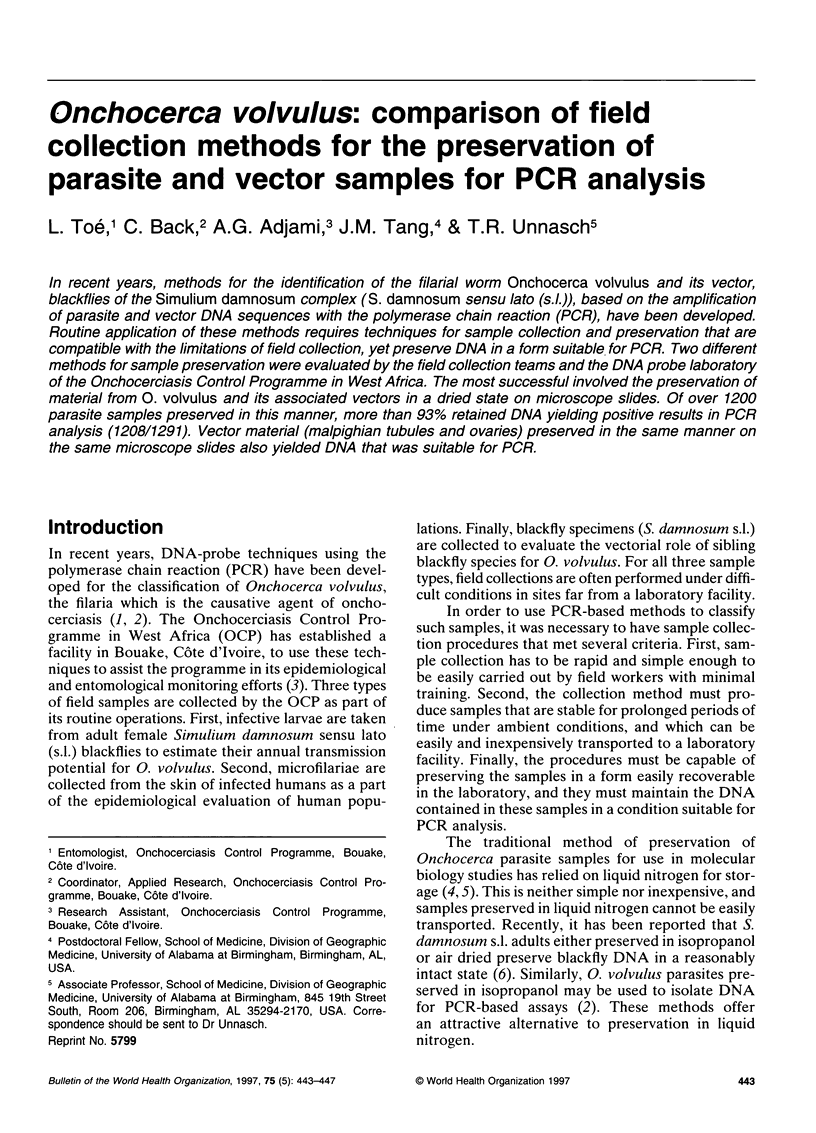Abstract
In recent years, methods for the identification of the filarial worm Onchocerca volvulus and its vector, blackflies of the Simulium damnosum complex (S. damnosum sensu lato (s.l.)), based on the amplification of parasite and vector DNA sequences with the polymerase chain reaction (PCR), have been developed. Routine application of these methods requires techniques for sample collection and preservation that are compatible with the limitations of field collection, yet preserve DNA in a form suitable for PCR. Two different methods for sample preservation were evaluated by the field collection teams and the DNA probe laboratory of the Onchocerciasis Control Programme in West Africa. The most successful involved the preservation of material from O. volvulus and its associated vectors in a dried state on microscope slides. Of over 1200 parasite samples preserved in this manner, more than 93% retained DNA yielding positive results in PCR analysis (1208/1291). Vector material (malpighian tubules and ovaries) preserved in the same manner on the same microscope slides also yielded DNA that was suitable for PCR.
Full text
PDF




Images in this article
Selected References
These references are in PubMed. This may not be the complete list of references from this article.
- Brockhouse C. L., Vajime C. G., Marin R., Tanguay R. M. Molecular identification of onchocerciasis vector sibling species in black flies (Diptera: Simuliidae). Biochem Biophys Res Commun. 1993 Jul 30;194(2):628–634. doi: 10.1006/bbrc.1993.1867. [DOI] [PubMed] [Google Scholar]
- Duke B. O. Special requirements for use of adult Onchocerca volvulus in molecular biology. Trop Med Parasitol. 1988 Dec;39 (Suppl 4):463–463. [PubMed] [Google Scholar]
- Kirkwood B., Smith P., Marshall T., Prost A. Variations in the prevalence and intensity of microfilarial infections by age, sex, place and time in the area of the Onchocerciasis Control Programme. Trans R Soc Trop Med Hyg. 1983;77(6):857–861. doi: 10.1016/0035-9203(83)90307-3. [DOI] [PubMed] [Google Scholar]
- Meredith S. E., Lando G., Gbakima A. A., Zimmerman P. A., Unnasch T. R. Onchocerca volvulus: application of the polymerase chain reaction to identification and strain differentiation of the parasite. Exp Parasitol. 1991 Oct;73(3):335–344. doi: 10.1016/0014-4894(91)90105-6. [DOI] [PubMed] [Google Scholar]
- Perler F. B., Karam M. Cloning and characterization of two Onchocerca volvulus repeated DNA sequences. Mol Biochem Parasitol. 1986 Nov;21(2):171–178. doi: 10.1016/0166-6851(86)90020-4. [DOI] [PubMed] [Google Scholar]
- Tang J., Toè L., Back C., Zimmerman P. A., Pruess K., Unnasch T. R. The Simulium damnosum species complex: phylogenetic analysis and molecular identification based upon mitochondrially encoded gene sequences. Insect Mol Biol. 1995 May;4(2):79–88. doi: 10.1111/j.1365-2583.1995.tb00011.x. [DOI] [PubMed] [Google Scholar]
- Toe L., Merriweather A., Unnasch T. R. DNA probe-based classification of Simulium damnosum s. l.-borne and human-derived filarial parasites in the onchocerciasis control program area. Am J Trop Med Hyg. 1994 Nov;51(5):676–683. [PubMed] [Google Scholar]
- Zimmerman P. A., Dadzie K. Y., De Sole G., Remme J., Alley E. S., Unnasch T. R. Onchocerca volvulus DNA probe classification correlates with epidemiologic patterns of blindness. J Infect Dis. 1992 May;165(5):964–968. doi: 10.1093/infdis/165.5.964. [DOI] [PubMed] [Google Scholar]



